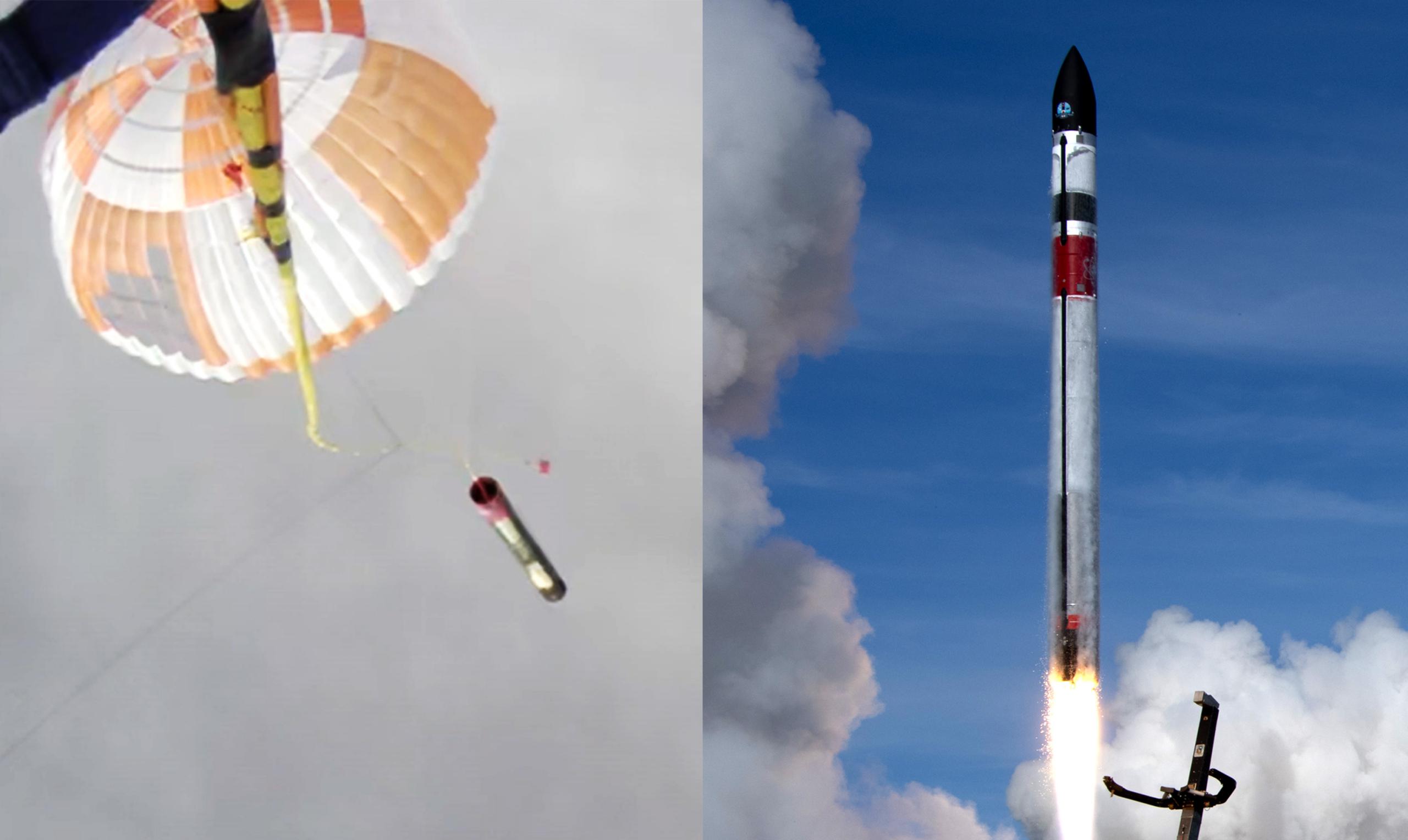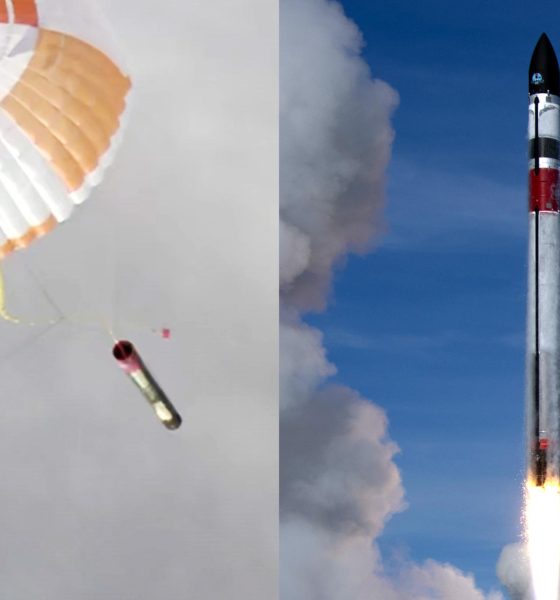

News
Rocket Lab briefly catches Electron booster with a helicopter on first try
In a significant achievement, public launch provider Rocket Lab has – with a few caveats – successfully used a helicopter to catch the booster of its Electron rocket out of mid-air on the very first attempt.
The company began working on ways to recover and reuse the booster of its tiny Electron rocket in 2019, going back on a promise repeatedly made by founder and CEO Peter Beck in the years prior. Due to just how small the Electron rocket is, it was generally assumed that Beck wasn’t wrong to avoid attempting to recover or reuse its parts of it. However, that attitude quickly changed when the need to ramp up launch cadence became a leading priority. Soon after, Beck revealed that Rocket Lab engineers had looked more carefully at the problem and concluded that Electron booster recovery was more feasible than assumed.
Once the problem was no longer deemed insurmountable, the allure of reuse – intrinsically multiplying the effectiveness of any given production line if done right – was irresistible.

While the change in attitude made Rocket Lab the second company after SpaceX to begin seriously developing the ability to recover and reuse orbital-class liquid rocket boosters, the approach it would need to take for a rocket as small as Electron was almost nothing like that used by Falcon boosters. Instead of multiple in-flight engine ignitions, supersonic retropropulsion, steerable fins, and a propulsive landing, Electron would rely on several parachutes to slow itself down, use small thrusters (not unlike Falcon) for attitude control, and be actively captured out of mid-air by a crewed helicopter.
Ironically, demonstrating the sheer size gap between Electron and Falcon 9, Electron booster recovery more closely resembles Falcon 9 fairing recovery. Weighing in at around one ton (~2200 lb) per half, or about as heavy as an entire Electron rocket booster, each fairing half mainly just controls its attitude with cold-gas thrusters while passively reentering Earth’s atmosphere. Fairing halves then deploy a GPS-guided parafoil and gently splash down on the ocean surface before being fished out of the water by a waiting ship.
That is exactly how Rocket Lab trialed Electron recovery on several prior attempts, fishing intact boosters out of the Pacific Ocean after gentle ocean landings. For a while, SpaceX even attempted to catch fairings out of mid-air – albeit with a highly-modified ship and net instead of a helicopter and hook. However, when the company realized it could easily reuse fairing halves that landed in the ocean, it fully abandoned catch attempts.
In Electron’s case, it’s no surprise that Rocket Lab still pursued catch-based recovery while SpaceX was simultaneously giving up on the practice. Put simply, it would be incredibly difficult to reliably and affordably reuse a liquid rocket booster – and liquid rocket engines especially – after dunking them in saltwater.
That’s also why the success of Rocket Lab’s first operational catch attempt has caveats. While the company did successfully catch the booster out of mid-air, the pilot – who holds final authority for the sake of safety – observed unusual behavior not seen during testing after hooking Electron and chose to release the booster early. Thankfully, it still managed a soft landing in the ocean and was recovered by ship, but despite statements from Beck to the contrary, that seawater exposure will almost certainly make it impossible to fully reuse. To call the attempt a total success, the helicopter would have needed to drop the booster off on the recovery ship’s deck, fully avoiding a bath.
Above all else, even if the catch didn’t last, Rocket Lab successfully launched 34 small satellites and payloads into orbit for several paying customers and briefly caught the booster that launched them with a helicopter. The attempt was arguably far more successful than not and likely leaves Rocket Lab just a little more practice and a few small optimizations away from a perfect recovery. Then the company can shift its focus to the next goal: the first Electron booster reuse.

News
Tesla FSD fleet is nearing 7 billion total miles, including 2.5 billion city miles
As can be seen on Tesla’s official FSD webpage, vehicles equipped with the system have now navigated over 6.99 billion miles.

Tesla’s Full Self-Driving (Supervised) fleet is closing in on almost 7 billion total miles driven, as per data posted by the company on its official FSD webpage.
These figures hint at the massive scale of data fueling Tesla’s rapid FSD improvements, which have been quite notable as of late.
FSD mileage milestones
As can be seen on Tesla’s official FSD webpage, vehicles equipped with the system have now navigated over 6.99 billion miles. Tesla owner and avid FSD tester Whole Mars Catalog also shared a screenshot indicating that from the nearly 7 billion miles traveled by the FSD fleet, more than 2.5 billion miles were driven inside cities.
City miles are particularly valuable for complex urban scenarios like unprotected turns, pedestrian interactions, and traffic lights. This is also the difference-maker for FSD, as only complex solutions, such as Waymo’s self-driving taxis, operate similarly on inner-city streets. And even then, incidents such as the San Francisco blackouts have proven challenging for sensor-rich vehicles like Waymos.
Tesla’s data edge
Tesla has a number of advantages in the autonomous vehicle sector, one of which is the size of its fleet and the number of vehicles training FSD on real-world roads. Tesla’s nearly 7 billion FSD miles then allow the company to roll out updates that make its vehicles behave like they are being driven by experienced drivers, even if they are operating on their own.
So notable are Tesla’s improvements to FSD that NVIDIA Director of Robotics Jim Fan, after experiencing FSD v14, noted that the system is the first AI that passes what he described as a “Physical Turing Test.”
“Despite knowing exactly how robot learning works, I still find it magical watching the steering wheel turn by itself. First it feels surreal, next it becomes routine. Then, like the smartphone, taking it away actively hurts. This is how humanity gets rewired and glued to god-like technologies,” Fan wrote in a post on X.
News
Tesla starts showing how FSD will change lives in Europe
Local officials tested the system on narrow country roads and were impressed by FSD’s smooth, human-like driving, with some calling the service a game-changer for everyday life in areas that are far from urban centers.

Tesla has launched Europe’s first public shuttle service using Full Self-Driving (Supervised) in the rural Eifelkreis Bitburg-Prüm region of Germany, demonstrating how the technology can restore independence and mobility for people who struggle with limited transport options.
Local officials tested the system on narrow country roads and were impressed by FSD’s smooth, human-like driving, with some calling the service a game-changer for everyday life in areas that are far from urban centers.
Officials see real impact on rural residents
Arzfeld Mayor Johannes Kuhl and District Administrator Andreas Kruppert personally tested the Tesla shuttle service. This allowed them to see just how well FSD navigated winding lanes and rural roads confidently. Kruppert said, “Autonomous driving sounds like science fiction to many, but we simply see here that it works totally well in rural regions too.” Kuhl, for his part, also noted that FSD “feels like a very experienced driver.”
The pilot complements the area’s “Citizen Bus” program, which provides on-demand rides for elderly residents who can no longer drive themselves. Tesla Europe shared a video of a demonstration of the service, highlighting how FSD gives people their freedom back, even in places where public transport is not as prevalent.
What the Ministry for Economic Affairs and Transport says
Rhineland-Palatinate’s Minister Daniela Schmitt supported the project, praising the collaboration that made this “first of its kind in Europe” possible. As per the ministry, the rural rollout for the service shows FSD’s potential beyond major cities, and it delivers tangible benefits like grocery runs, doctor visits, and social connections for isolated residents.
“Reliable and flexible mobility is especially vital in rural areas. With the launch of a shuttle service using self-driving vehicles (FSD supervised) by Tesla in the Eifelkreis Bitburg-Prüm, an innovative pilot project is now getting underway that complements local community bus services. It is the first project of its kind in Europe.
“The result is a real gain for rural mobility: greater accessibility, more flexibility and tangible benefits for everyday life. A strong signal for innovation, cooperation and future-oriented mobility beyond urban centers,” the ministry wrote in a LinkedIn post.
News
Tesla China quietly posts Robotaxi-related job listing
Tesla China is currently seeking a Low Voltage Electrical Engineer to work on circuit board design for the company’s autonomous vehicles.

Tesla has posted a new job listing in Shanghai explicitly tied to its Robotaxi program, fueling speculation that the company is preparing to launch its dedicated autonomous ride-hailing service in China.
As noted in the listing, Tesla China is currently seeking a Low Voltage Electrical Engineer to work on circuit board design for the company’s autonomous vehicles.
Robotaxi-specific role
The listing, which was shared on social media platform X by industry watcher @tslaming, suggested that Tesla China is looking to fill the role urgently. The job listing itself specifically mentions that the person hired for the role will be working on the Low Voltage Hardware team, which would design the circuit boards that would serve as the nervous system of the Robotaxi.
Key tasks for the role, as indicated in the job listing, include collaboration with PCB layout, firmware, mechanical, program management, and validation teams, among other responsibilities. The role is based in Shanghai.
China Robotaxi launch
China represents a massive potential market for robotaxis, with its dense urban centers and supportive policies in select cities. Tesla has limited permission to roll out FSD in the country, though despite this, its vehicles have been hailed as among the best in the market when it comes to autonomous features. So far, at least, it appears that China supports Tesla’s FSD and Robotaxi rollout.
This was hinted at in November, when Tesla brought the Cybercab to the 8th China International Import Expo (CIIE) in Shanghai, marking the first time that the autonomous two-seater was brought to the Asia-Pacific region. The vehicle, despite not having a release date in China, received a significant amount of interest among the event’s attendees.








